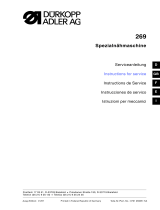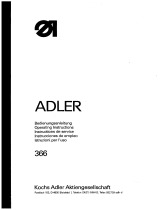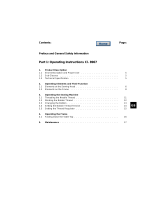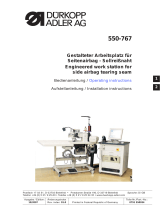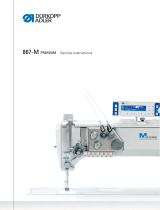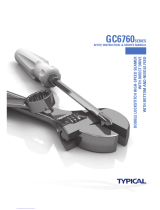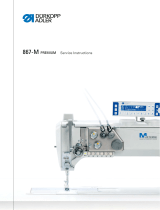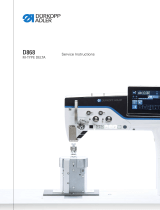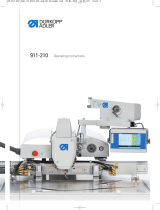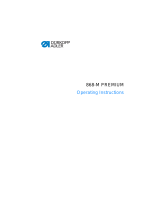Page is loading ...

550-867
Operating Instructions


Foreword
This instruction manual is intended to help the user to become familiar
with the machine and take advantage of its application possibilities in
accordance with the recommendations.
The instruction manual contains important information on how to
operate the machine securely, properly and economically. Observation
of the instructions eliminates danger, reduces costs for repair and
down-times, and increases the reliability and life of the machine.
The instruction manual is intended to complement existing national
accident prevention and environment protection regulations.
The instruction manual must always be available at the machine/sewing
unit.
The instruction manual must be read and applied by any person that is
authorized to work on the machine/sewing unit. This means:
– Operation, including equipping, troubleshooting during the work
cycle, removing of fabric waste,
– Service (maintenance, inspection, repair) and/or
– Transport.
The user also has to assure that only authorized personnel work on the
machine.
The user is obliged to check the machine at least once per shift for
apparent damages and to immediatly report any changes (including the
performance in service), which impair the safety.
The user company must ensure that the machine is only operated in
perfect working order.
Never remove or disable any safety devices.
If safety devices need to be removed for equipping, repairing or
maintaining, the safety devices must be remounted directly after
completion of the maintenance and repair work.
Unauthorized modification of the machine rules out liability of the
manufacturer for damage resulting from this.
Observe all safety and danger recommendations on the machine/unit!
The yellow-and-black striped surfaces designate permanend danger
areas, eg danger of squashing, cutting, shearing or collision.
Besides the recommendations in this instruction manual also observe
the general safety and accident prevention regulations!

General safety instructions
The non-observance of the following safety instructions can cause
bodily injuries or damages to the machine.
1. The machine must only be commissioned in full knowledge of the
instruction book and operated by persons with appropriate training.
2. Before putting into service also read the safety rules and
instructions of the motor supplier.
3. The machine must be used only for the purpose intended. Use of
the machine without the safety devices is not permitted. Observe all
the relevant safety regulations.
4. When gauge parts are exchanged (e.g. needle, presser foot, needle
plate, feed dog and bobbin) when threading, when the workplace is
left, and during service work, the machine must be disconnected
from the mains by switching off the master switch or disconnecting
the mains plug.
5. Daily servicing work must be carried out only by appropriately
trained persons.
6. Repairs, conversion and special maintenance work must only be
carried out by technicians or persons with appropriate training.
7. For service or repair work on pneumatic systems, disconnect the
machine from the compressed air supply system (max. 7-10 bar).
Before disconnecting, reduce the pressure of the maintenance unit.
Exceptions to this are only adjustments and functions checks made
by appropriately trained technicians.
8. Work on the electrical equipment must be carried out only by
electricians or appropriately trained persons.
9. Work on parts and systems under electric current is not permitted,
except as specified in regulations DIN VDE 0105.
10. Conversion or changes to the machine must be authorized by us
and made only in adherence to all safety regulations.
11. For repairs, only replacement parts approved by us must be used.
12. Commissioning of the sewing head is prohibited until such time as
the entire sewing unit is found to comply with EC directives.
13. The line cord should be equipped with a country-specific mains
plug. This work must be carried out by appropriately trained
technicians (see paragraph 8).
It is absolutely necessary to respect the safety
instructions marked by these signs.
Danger of bodily injuries !
Please note also the general safety instructions.

Index Page:
Preface and General Safety Instructions
Part 1: Operating Instructions Class 550-867 – Original Instructions
(Edition 12/2011)
1 Product Description ........................................... 5
2 Designated Use .............................................. 8
3 Optional Equipment ........................................... 8
4 Technical Data .............................................. 9
5 Operating
5.1 Threadingtheneedlethread....................................... 10
5.1.1 Machineswithelectronicallycontrolledneedlethreadtension(ETT)............... 11
5.1.2 Machines with mechanically set needle thread tension and with
electromagnetictensionrelease..................................... 12
5.2 Adjustingtheneedle-threadtension(mechanically)......................... 13
5.3 Adjustingtheneedle-threadtension(ETT)............................... 13
5.4 Adjustingthethreadregulator...................................... 14
5.5 Winding on the hook thread ....................................... 15
5.6 Threading in the hook thread....................................... 16
5.7 Inserting the hook thread bobbin with machines equipped with residual thread monitor. . . 17
5.8 Setting the hook thread tension ..................................... 18
5.9 Changingtheneedle............................................ 19
5.10 Liftingthesewingfeet........................................... 20
5.11 Lockingthesewingfeetinliftedposition............................... 20
5.12 Settingthesewing-footstroke...................................... 21
5.13 Sewing-footpressure........................................... 21
5.14 Settingthestitchlength.......................................... 22
5.15 Switch-keyonthemachinearm..................................... 22
5.16 LEDsonthetensionplate ........................................ 25
5.17 Residual-threadmonitorRFW20–7.................................. 25
5.18 Electro-pneumaticrapidstrokeadjustment.............................. 27
5.19 Uninterruptiblepowersupply(UPS) .................................. 28
5.20 Sewinglamp ................................................ 28
6 Operating the tearing seam visualization
6.1 Accessing the system ........................................... 29
6.1.1 Logging in with scanner and barcode ................................. 29
6.1.2 Logging in via the menu .......................................... 30
6.1.3 Logging out of the system ........................................ 31
6.2 Exitingtheprogram............................................ 32

Index Page:
7Sewing
7.1 Seamscanner(optional) ......................................... 36
8 Maintenance
8.1 Cleaning and Checking .......................................... 37
8.2 Repair .................................................... 39

1 Product Description
The DÜRKOPP ADLER class 550-867 is a sewing unit designed for
documented airbag tearing seams.
Single needle flat bed double lockstitch sewing machine class 867
with bottom feed, needle feed and alternating upper feed.
With electromagnetic actuated thread trimmer and sewing foot lifting.
Electromotor driven stitch length setting and seam bartacking.
Technical specifications sewing unit
·
Extra-large, two-piece vertical hook (XXL)
·
The maximum fabric clearance underneath the sewing feet is
20 mm.
·
The remaining thread length after thread trimming is about 7 mm
with a short thread trimmer equipment.
·
The snap fit coupling prevents the displacing and damaging of the
hook at thread deflection
·
Automatic wick lubricating with an inspection glass on the arm for
the machine and hook lubrication.
·
Stitch length setting via step motor
·
Multi-position cylinder for the adjustment of the sewing-foot
stroke
·
Rapid stroke adjustment with automatic speed adaption
·
Electronically controlled needle thread tension (ETT= electronic
controlled needle thread tension)
or
mechanically set needle thread tension and with electromagnetic
tension release
·
Residual thread monitor RFW 20–7
·
Thread tension sensor
·
Motor driven bobbin winder with automatic wind on
·
Specially designed bobbin in order to prevent errors through the
insertion of inadequate bobbins
·
Stand is adjustable in height
·
Monitoring of the throat plate slide at bobbin change
·
Fabric edge guide with integrated glass fibre optics light barrier in
order to recognize the strip on the cuts and LED to recognize the
seam segment (tearing seam = red, free seam = green)
·
Upper feed pressure can be locked
·
Barcode printer
·
15" industrial touch panel PC
·
Needle and hook thread cone monitoring via proximity switch
·
Manual scanner
·
Log in system via manual scanning
·
Reel stand for 6 thread cones
5

Technical specifications software
·
Intuitive user interface
·
Sewing programs with up to 30 seam segments
·
Switching over via strip detection, stitch counting or manually
·
Different setup masks and endlabel masks can be memorized
·
Teach-in function for ETT (electronically controlled needle thread
tension)
·
Test window for the thread tension
·
Display of the thread tension during sewing
·
Recognition of the needle and hook thread via barcode scanning
(if the option is available)
·
Recognition of the material part 1 and / or part 2 (resp. part 3) via
manual scanning
·
Alle seam sections can be defined with various parameters
·
The following parameters are automatically suppressed in the
rupture seam segment
·
RS function (bartacking via step motor)
·
HP function (pneumatic stroke adjustment)
·
FA function (thread trimmer)
·
Optical indicator “tearing seam” in the visual field of the operator
(LED - red)
·
Evaluation of the collected material data
·
Monitoring and active adjustment of the needle tread tension (only
ETT (electronically controlled needle thread tension))
·
Automatic thread breakage recognition
·
Deviations from the nominal values during a seam are recognized
and lead to a sewing stop
·
The sewing process can be stopped in the segment of the lateral
airbag by the seamstress.
In order to do this the “FA” button has to be pressed and
additionally the foot pedal has to be pushed into position 2.
The message “not O.K.” will be automatically issued for this seat.
·
After completing the last seam section all sewing parameters will
be memorized and the request to scan the next material bar codes
appears
·
Data entry in a data base or in a ASCII file
·
Different levels authorized for operators, supervisors and
production manager
·
Data backup also during power outage via UPS (Uninterruptible
power supply)
6

Data entry
·
Date
·
Time
·
Line number
·
Endlabel barcode
·
Entrance barcode 1 - 3
·
Barcode needle thread
·
Barcode hook thread
·
Additional barcode information (max. 9)
·
Bobbin number
·
Bobbin winder information
·
Bobbin insertion information
·
Operator name
·
Number of seam sections
·
Set stitch length per seam section
·
Absolute seam section length
·
Calculated stitch length
·
Thread tension window
·
Stitch counting
·
Name of seam pattern
·
Machine number
·
Manufacturer’s identification number
·
Cycle time
·
Error code
·
Cycle number
·
Thread tension data for individual stitches
·
Daily number
7

2 Designated Use
The class 550-867 is an configured sewing station designed for the
sewing of light to medium-heavy material. Such material is generally
made of textile fibers, but it may also be leather.
These materials are used in the clothing industry and for domestic and
motor-vehicle upholstery.
It is also possible to produce so-called technical seams with this
configured sewing station. In this case, however, the operator must
assess the possible dangers which may arise (DÜRKOPP ADLER AG
would be happy to assist with this assessment), since such
applications are on the one hand relatively unusual and, on the other,
so varied that no single set of criteria can cover t hem all. The outcome
of this assessment may require to take appropriate safety measures.
Generally only dry material may be sewn with this sewing machine.
The material must not be thicker than 10 mm when compressed by the
lowered sewing feet. The material may not contain any hard objects.
Otherwise the machine may only be operated with an eye-protection
device. Such an eye-protection device is currently not available.
The seam is commonly sewn with sewing threads made from textile
fibers of the dimensions up to 11 / 3 NeB (cotton threads), 11 / 3 Nm
(synthetic threads) or 11 / 4 Nm (core threads). If other types of thread
aretobeused,thepossibledangersarisingfromithavetobe
assessed and, if necessary, safety measures have to be taken.
This configured sewing station may be set up and operated only in
dry, well-maintained premises. If the sewing unit is used in premises
which are not dry and well-maintained, it may be necessary to take
further precautions which should be agreed in advance (see
EN 60204-31:1999).
As manufacturers of industrial sewing machines we proceed on the
assumption that personnel that works on our products will have
received training at least sufficient to acquaint them with all normal
operations and with any hazards which these may involve.
3 Optional equipment
For the class 550-867 the following optional equipment is available:
Order-No. Optional equipment
9800 330010 Control panel V 820
0867 590724 Head cover scanner incl. holder to check the endlabel
0867 590904 Scanner with holder (2x) to enter the needle- and hook
thread cone bar codes
0867 590924 Scanner (2x) for the bobbin monitoring via barcode on
the bobbin winder and hook
0867 590014 Needle cooling NK 20-1
0867 590054 Needle cooling NK 20-5
8

4 Technical data
Noise: Lc = dB (A)
Workplace-related emission value in accordance with
DIN EN ISO 10821
Speed: min
-1
Material:
Sewing stitch type: 301 / double lock stitch
Number of needles: 1
Needle system: 134/35
Needle size : [NM] 90 - 140
Needle thread size
- Cotton: [NeB] 20/3
- Synthetic sewing thread: [Nm] 20/3
- Core thread [Nm] 20/3
Bobbin wind-on capacity with
synthetic sewing thread
- 60/3: [m] 98
Number of stitches:
- with HP equipment: [min
-1
] 3400
- factory setting: [min
-1
] 3400
Stitch length:
Forwards and backwards [mm] 0 - 6 (9)
Lift stroke of sewing feet:
- max. [mm] 9
Clearance underneath sewing feet
- Sewing [mm] 10
- Lifted: [mm] 20
Operating pressure: [bar] 6
Air consumption: about [NL] 0.7
Length, width, height (incl. PC) [mm] 1600 x 920 x 1550
Weight: [kg] about 194
Rated voltage: [V, Hz] 1~ 190 - 240 V, 50/60 Hz
Input power: [KVA] 1 kVA
9

5 Operating
5.1 Threading the needle thread
Caution: Risk of Injury !
Tur n off the main switch!
The needle thread may only be threaded with the sewing machine
being switched off.
Before putting in the needle thread cones they need to be scanned
with the hand scanner.
With thread barcode scanner equipment (optional):
–
Unscrew the ball 1.
–
Put the cone 2 on the stand and make sure that the barcode 4 on
the thread reel can be read by the optional thread barcode
scanner 5.
If the scanner does not recognize the barcode an error message
will appear on the monitor.
–
Tighten the reel with ball 1 and washer 3.
–
Lead the needle thread through the unwinder arm 6.
The unwinder arm must be in vertical position above the thread
reels.
–
Conduct the needle thread through the guiding tube 7.
10
32 1
54
76

5.1.1 Machines with electronically controlled needle thread tension (ETT)
–
Conduct the thread through the threading guide 1 and clockwise
around the pretensioner 2.
–
Conduct the thread counter-clockwise around the tensioner 3.
–
Conduct the thread clockwise around the tensioner 4.
–
Conduct the thread through threading guide 5.
–
Pull the thread underneath the thread take-up spring 7 and
conduct it through the thread regulator 6 to the thread lever 9.
–
Conduct the thread through the thread lever 9 and the thread
tension sensor 8.
–
Conduct the thread through the thread clamp 10 and the threading
guides 11 and 12 on the needle bar.
–
Thread the thread into the needle eye 13.
11
1
2
3
4
9
8
765
10
11
12
13

5.1.2 Machines with mechanically set needle thread tension and with electromagnetic
tension release
–
Conduct the thread through the threading guide 1 and clockwise
around the pretensioner 2.
–
Conduct the thread counter-clockwise around the tensioner 3.
–
Conduct the thread clockwise around the tensioner 4.
–
Conduct the thread through threading guide 5.
–
Pull the thread underneath the thread take-up spring 7 and
conduct it through the thread regulator 6 to the thread lever 9.
–
Conduct the thread through the thread lever 9 and the thread
tension sensor 8.
–
Conduct the thread through the thread clamp 10 and the threading
guides 11 and 12 on the needle bar.
–
Thread the thread into the needle eye 13.
12
1
2
3
4
9
8
765
10
11
12
13

5.2 Adjusting the needle-thread tension (mechanically)
The tension is to be set according to the values given by the seat
cover manufacturers. The cross-over point should lie in the center of
the material.
–
The pretensioner 1 is preset.
–
Unscrew the locking plate 3.
–
Set the main tensioner 2 and 4.
–
Mount the locking plate 3 again.
5.3 Adjusting the needle-thread tension (ETT)
The thread tension is set via the machine’s software.
13
1
2
3
4

14
5.4 Adjusting the thread regulator
Caution: Risk of injury!
Tur n off the main switch.
The thread regulator may only be adjusted with the sewing machine
switched off.
The thread regulator 1 c ontrols the quantity of needle thread required
for stitch formation.
The thread regulator must be precisely adjusted for an optimum result.
With correct setting the needle-thread loop must slide with low
tension over the thickest point of the hook.
–
Loosen screw 2.
–
Adjust position of the thread regulator 1.
Thread regulator to the left = more thread
Thread regulator to the right = less thread
–
Tighten screw 2.
Adjustment information:
If the maximum quantity of thread is required, the thread-tensioning
spring 3 must be pulled upwards about 0.5 mm from its lower limit
position. This is the case, when the needle-thread loop passes the
maximum hook diameter.
32 1

5.5 Winding on the hook thread
ATTENTION!
Only use bobbins that are specially designed for this machine type!
–
Put the hook thread cone on the thread stand.
–
Conduct the hook thread through the threading guide on the
unwinder arm and through the tube 1.
–
Conduct the thread counter-clockwise around the tensioner 3.
–
Conduct the thread through threading guide 2 to t he bobbin 4.
–
Pull the thread beginning behind the tear-off knife 6 and tear it off.
–
Swivel the winder lever 5 against the empty bobbin.
–
Enter the number of the bobbin via touch s creen on the monitor.
When the bobbin is filled, the winding will be automatically
stopped by the winder lever 5.
Caution!
Please make sure that the entered number corresponds to t he
bobbin number before actuating the “Return” key.
“Return”
15
1
32
65 4

5.6 Threading in the hook thread
Caution: Risk of injury!
Tur n off the main switch!
The hook thread may only be threaded with the sewing machine being
switched off.
–
Raise up the flap 1 and remove the empty bobbin 2.
–
Insert the bobbin 2 in a way that it moves in counter-clockwise
direction when unwinding the thread.
–
Conduct the thread through slot 3 and underneath the spring 4.
–
Pull the thread through the slot 6 and continue pulling until it
stands out about 3 cm.
–
Close the flap 1 and pull the thread through the thread guiding 5 of
the flap 1.
16
654
1
2
3

17
5.7 Inserting the hook thread bobbin with machines equipped with residual
thread monitor
ATTENTION!
The hook bobbin has to be inserted so that the milling 1 is turned
downwards.
The area around the bobbin housing and the light barrier has to be
cleared of sewing dust !
Winding on the bobbin thread
ATTENTION!
When winding the thread on, the milling 1 has to be positioned
towards the machine so that the thread is first wound into the
reservegroove2.
1
2

18
5.8 Setting the hook thread tension
Caution: Risk of injury!
Tur n off the main switch.
The hook thread tension may only be adjusted with the sewing
machine switched off.
Setting the tension spring 2
–
Set the tension spring 2 by tur ning the adjustment screw 1.
Increase the hook thread tension =
Tur n screw 1 clockwise
Decrease the pressure =
Tur n screw 1 counter-clockwise.
21
/
